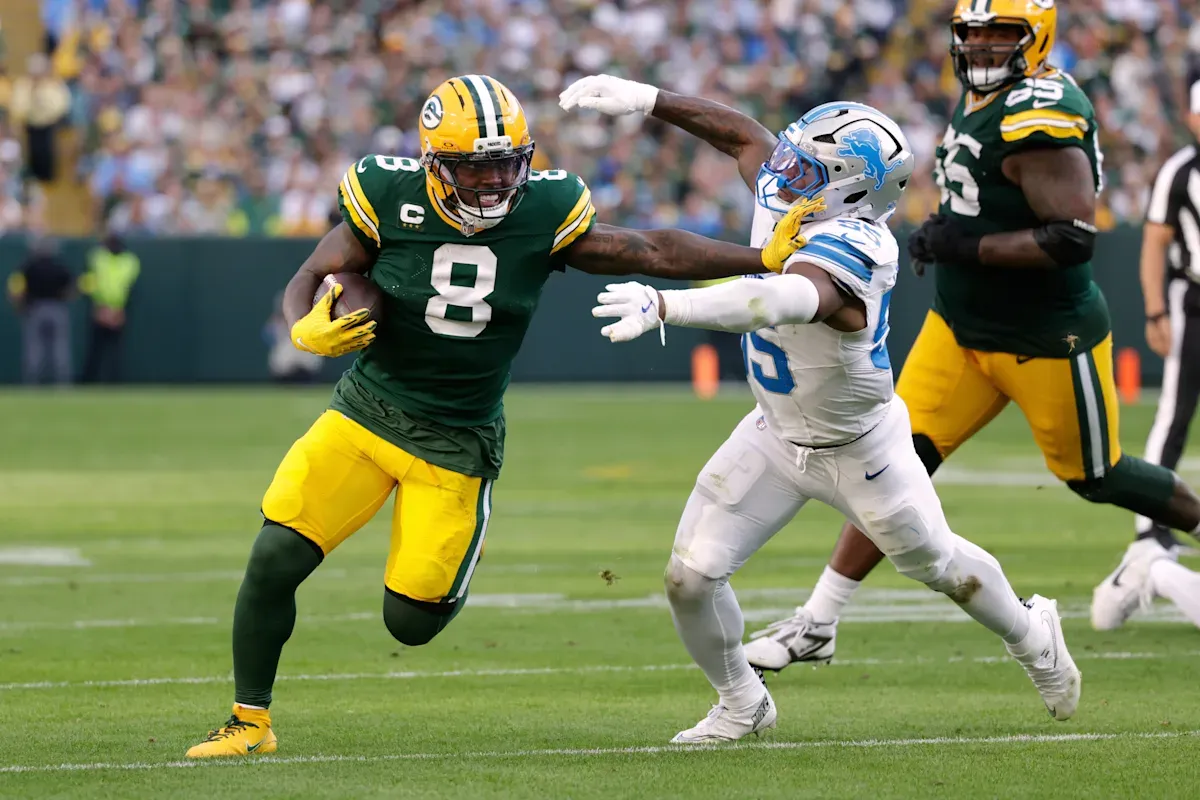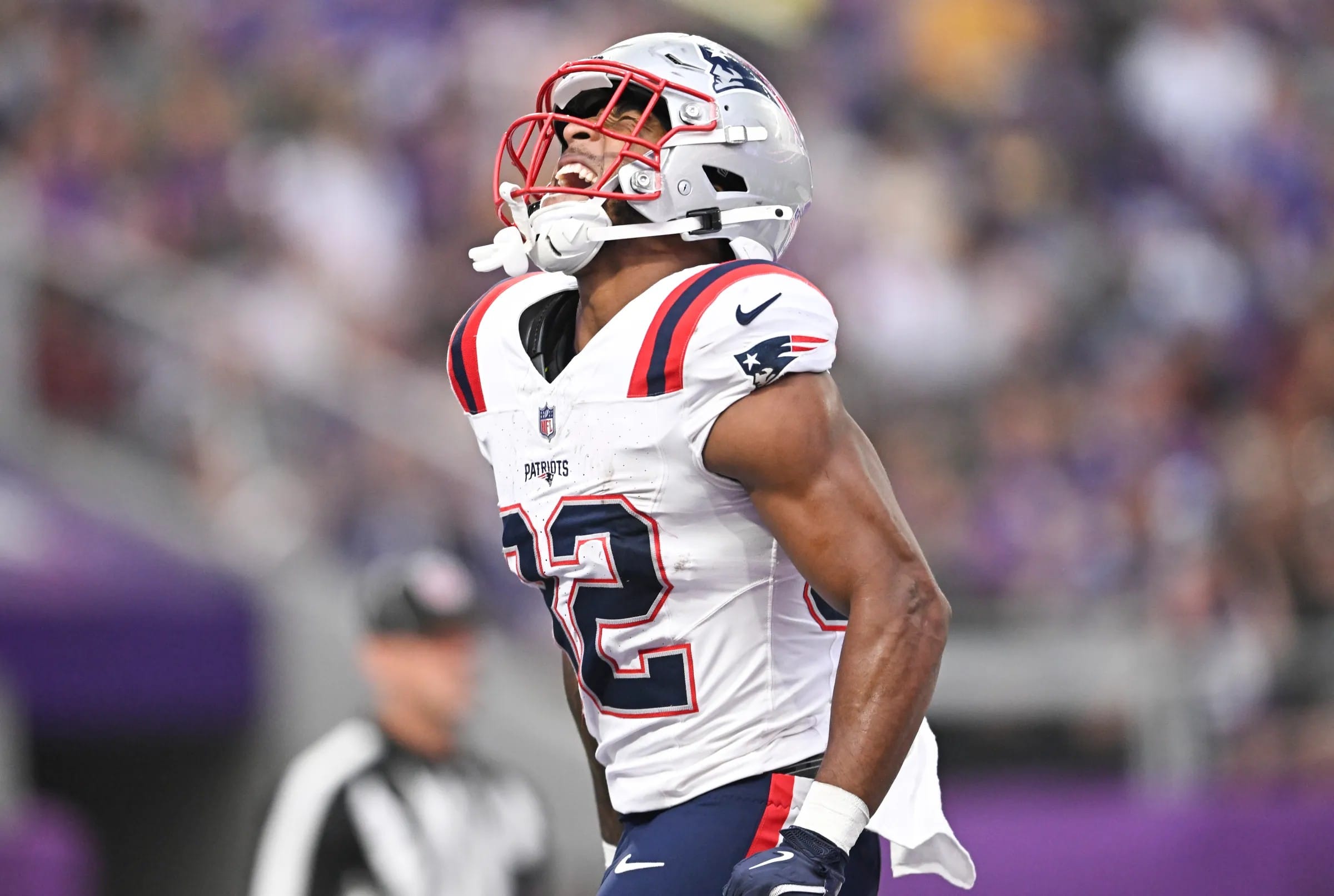
Quick Slant: TNF - The Hate, As It Turns Out, Is More Fun
Mat Irby’s Quick Slant
Cambridge-born Vaudevillian Fred Allen fled New England’s stiff traditions, parsimony, and old workings for the vital organism of New York—vibrant, improper, unchaste—long ago. He lamented the difference on his radio show years later: “I have just returned from Boston. It is the only thing to do if you find yourself up there.”
Forty miles north of Plymouth Rock, Boston is a colonial-born city with a Puritanical pretext. Its values—hard work, education, moral rigor, and thrift—are fused to the spinal cord of the American Way. Boston is deeply tied to academia—Harvard, M.I.T., Tufts, and Boston University—tributary to its self-imposed role as guardian of civic virtue. It lives in the gray area between the reformist impulse of Sam Adams—its punk side—and the cultural conservatism of Cotton Mather—its churchy side. It still bears the immigrant pockets of its past, proudly infused into the landscape like fig wasps—neighborhoods, like fortresses, that served as a harbor for marginalized Irish, Jewish, and Italian communities—still standing, still wary of outsiders.
In 2006, Michael Joseph Gross wrote for Boston Magazine: “Boston is what's good for you. Boston is hard work and not always fun, and the payoff will come later. Boston is eating your spinach, it's saving for retirement, it's the geek who does more homework than he needs to.” In the same article, Gross quoted John Updike: “Old Bostonians don't care whether they go to heaven or hell as long as their fellow club members are there.” As cosmopolitan as Boston feels, it is also like America’s biggest small town—a place at once intimate, lived-in, and locally accountable.
Contrast this with New York’s globalism: Wall Street, endless sprawl, the blinding lights of Times Square that bring Blade Runner to life; it’s a city that prides itself on the fact that nothing is ever simple or easy. Boston fits into a tidy 48 square miles. New York sprawls across 302. New York seems to stretch as high as it does wide, piercing the sky with 14 towers that were once the world’s tallest. Boston’s most famous structure—a century-old baseball stadium—sits inconspicuously on Jersey Street, green and red-brick, like a warehouse, appearing unannounced to unsuspecting pedestrians. Boston is a city where everyone seems to take ownership of everybody; New York fills itself with 23 million strangers every day.
James Weldon Johnson wrote of New York: “New York City is the most fatally fascinating thing in America. She sits like a great witch at the gate of the country, showing her alluring white face and hiding her crooked hands and feet under the folds of her wide garments—constantly enticing thousands from far within, and tempting those who come from across the seas to go no farther. And all these become the victims of her caprice… a few she favors and fondles, riding them high on the bubbles of fortune; then with a sudden breath she blows the bubbles out and laughs mockingly as she watches them fall.”
Boston is filled with hostile agents who hold other hostile agents as family worth dying for. New York is contemptuous; its natives welcome strangers to accept Frank Sinatra’s dare, but always doubt they’ll “make it there.”
New York and Boston are like brothers, bound by their shared experience of surviving cold winters, a love of sports, or mutual relevance that predates the United States itself. But each holds contempt for the other—jealousy, suspicion, and fierce pride.
It would be better if the Patriots’ AFC East rival were the Giants, not the Jets. The Giants, Yankees, Knicks, and Rangers crowd is substantively Gatsby, Rockefeller, and J.P. Morgan; the Jets, Mets, Nets, and Islanders’ inverse is generally Marciano, Guthrie, and Gompers. They fix your car, teach your kids, and operate the “E.” If they could set aside their rivalry with New England, they might even enjoy a beer together and rib each other about bagels and Babe on a barstool. But the hate, as it turns out, is more fun.
Jets
Implied Team Total: 15.5
The Jets are significant underdogs, with a 12.5-point spread, the largest of the week. This matchup features the highest implied team total (Patriots at 28) against the lowest (Jets at 15.5, tied with Tennessee). After losing their first seven games, the Jets are on a two-game winning streak.
Although perception still suggests that the Jets are the worst team, Pythagorean expected wins paint a slightly different picture, with New York pacing at 6.7 expected wins, which would surpass several teams.
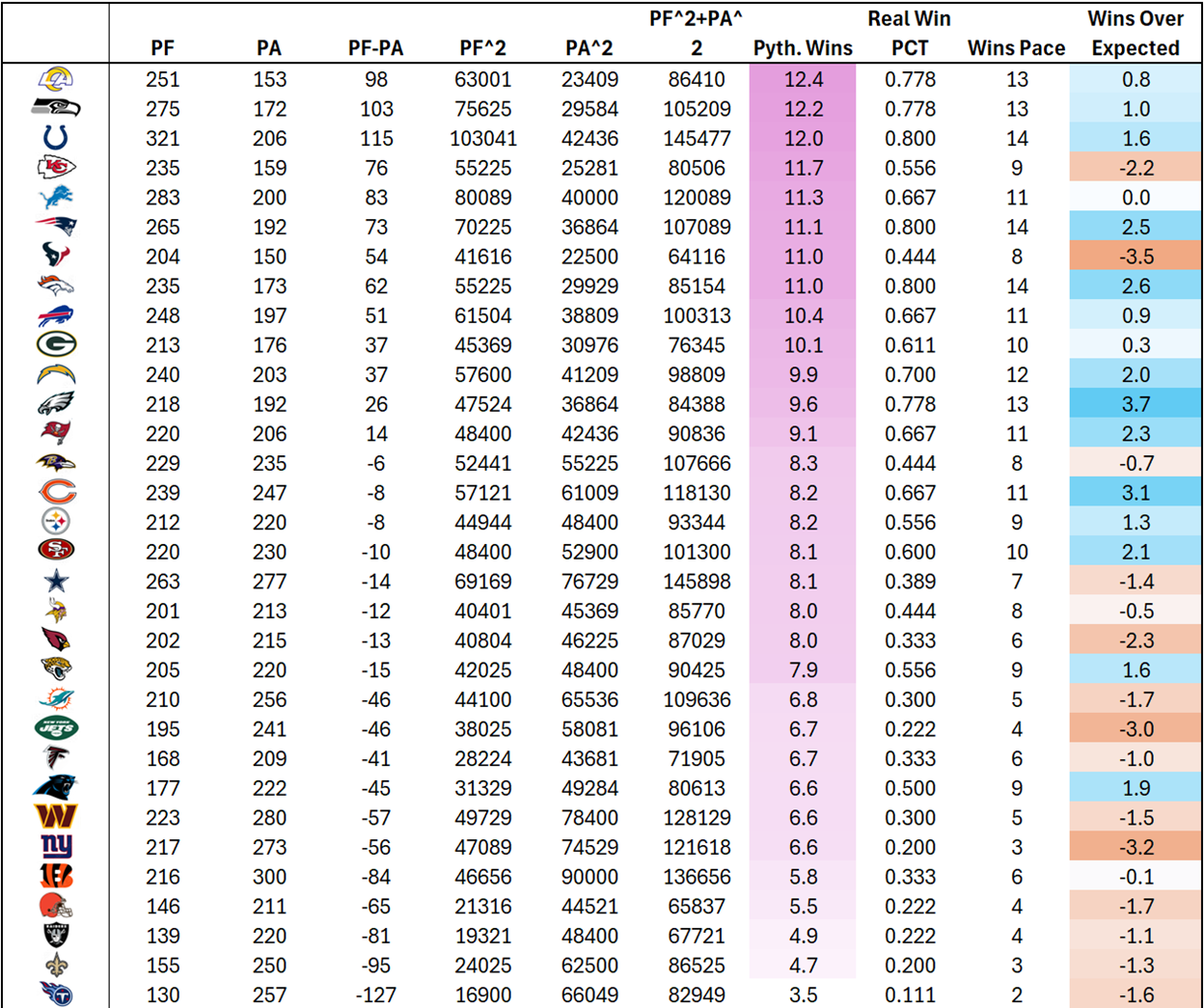
The Jets are inefficient on both offense and defense, ranking below average in each area.
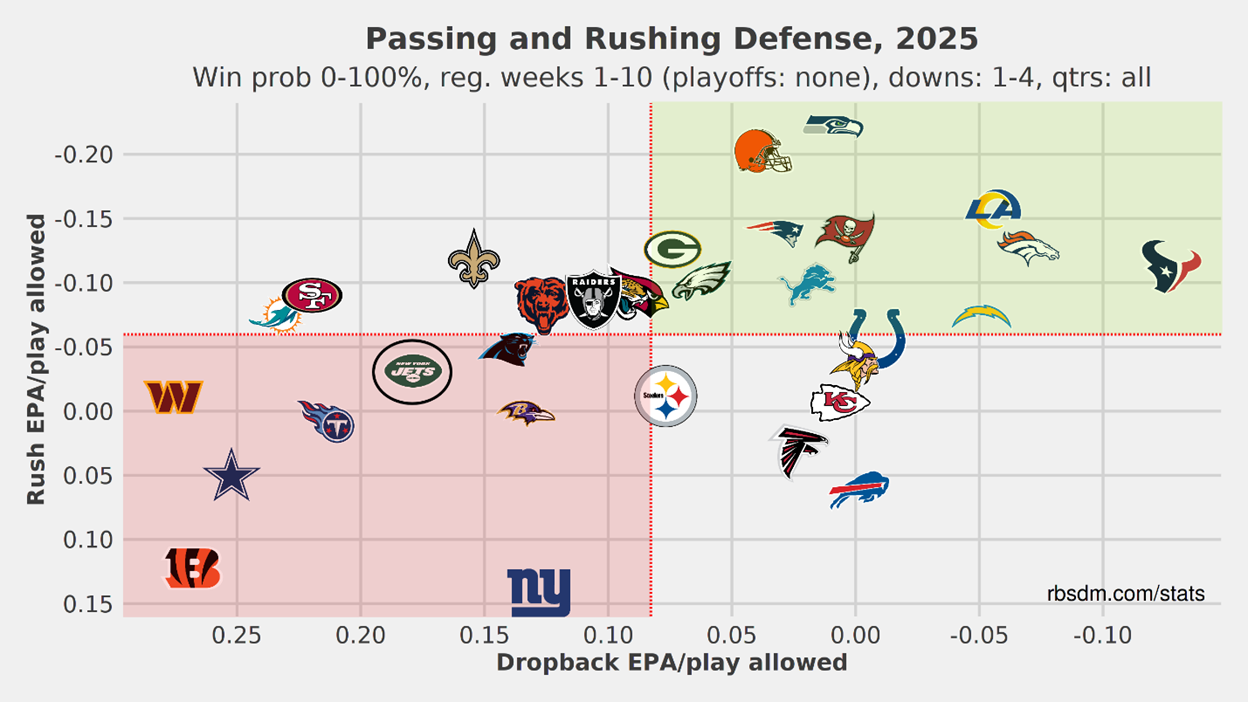
The Jets’ offense ranks 27th in offensive EPA per play and 23rd in offensive success rate. They rank 27th in offensive EPA per dropback and 28th in offensive success rate on dropbacks.

The Jets’ offense is below average in rush EPA and well below average in dropback EPA.
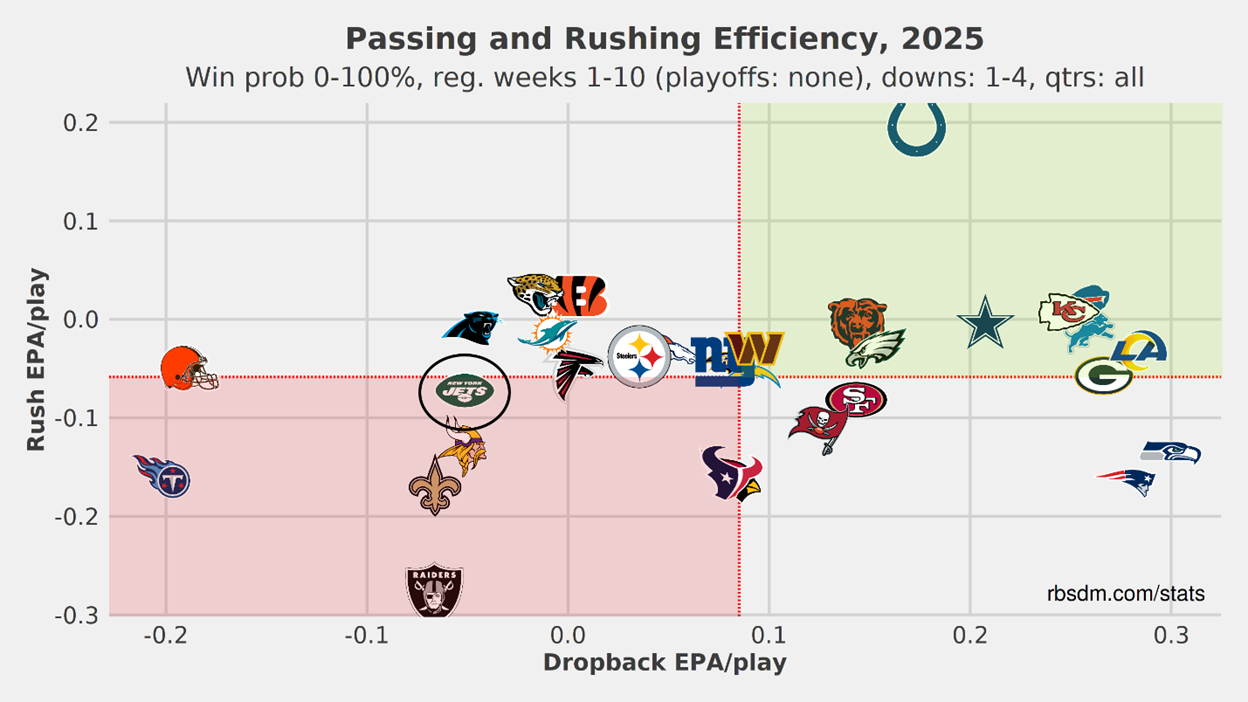
The Jets’ season-long pass rate is 53% (28th). They are average in terms of getting snaps off at the line (26.6 seconds to snap, T-16th). They are 31st in pass rate over expected (PROE) at -5.6%.

The Jets have spent a significant amount of time trailing by seven or more points (43.2% of offensive snaps, 6th). When trailing by as much, the Jets’ pass rate climbs to 65% (19th). Therefore, despite their inclination to run, they are frequently forced to operate at a higher pass rate due to the game script. The Jets run 62 plays per 60 minutes (22nd), a relatively low overall play volume.
As an overarching thesis, the vacuousness of the overall fantasy environment in New Jersey would dictate that we should refrain from using Jets in general. However, there are still a few pathways to fantasy relevance for a handful of players; this requires that we dig a little deeper to identify the options, and then have the cajónes to give them a try.
Let’s start with Fields. Fields has 28.5 dropbacks per game (34th) to begin with. He converts only 78.1% of his dropbacks into attempts (22.25 attempts per game, 35th), the second-lowest conversion rate among players with at least 100 attempts. This means that Fields takes a higher amount of sacks and/or scrambles than most. With Fields, both are true.
Fields has taken 25 sacks (T-6th). His pressure-to-sack-rate is 24.8% (T-4th-highest). He also has 24 scrambles (8th), accounting for 40% of his total rushes (60, 3rd). He has converted his 60 carries into 316 rushing yards (3rd) for three TDs (T-7th).
We like the elevated platform his rushing provides. Starting from the headstart that strong rushing provides a QB, he can either hit a high ceiling, as with Lamar Jackson and Josh Allen, or an elevated floor (meaning protection against the lack of accumulation of other meaningful stats). Fields is essentially the textbook example of the latter.
No modern QB has ever had as many rushing yards as Fields has, while also having so few passing yards.

As a thrower, Fields is firmly among the worst starters in the league. He is 30th of 33 QBs with at least 176 offensive plays in EPA + CPOE composite, topping only Cam Ward, Dillon Gabriel, and Trevor Lawrence.
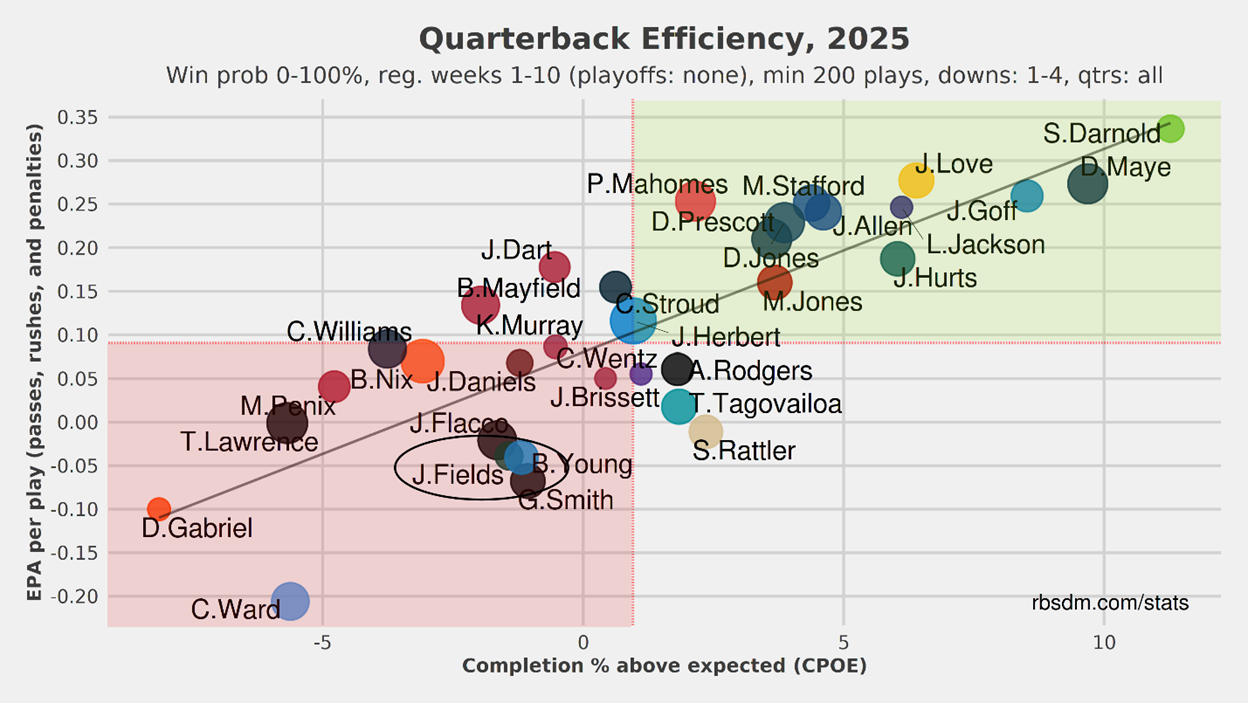
Even so, Fields is always a threat to score relevant fantasy points whenever he has a fairly decent passing day; so, season-long, he is no threat to hit ceiling, but in any single game, he can. As such, I would argue that he is always playable depending on a GM’s personal tolerance for having one of their QBs completely crater. I pretty much only play for upside in most formats, so I’m happier to play Fields, knowing a complete landmine is on the table, than I am playing similarly regarded analogs, such as Lawrence or Bryce Young.
New England’s defense has been above-average in both dropback EPA allowed and rush EPA allowed.
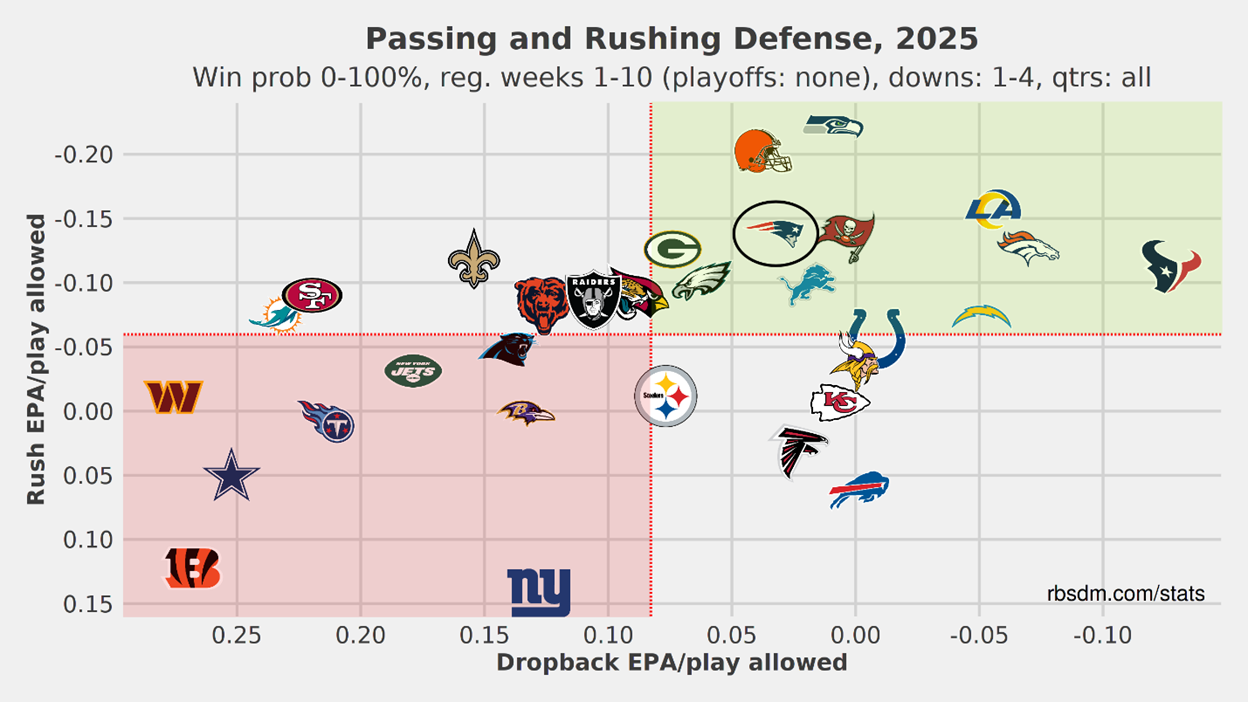
The Patriots’ defense has been relatively stingy against fantasy QBs. Included, opposing QBs have ranked 25th in rushing yards against them in their last five games. This consists of some who are decent runners when called upon (Rattler, Mayfield, Gabriel), but none who are anything like Fields on the ground.
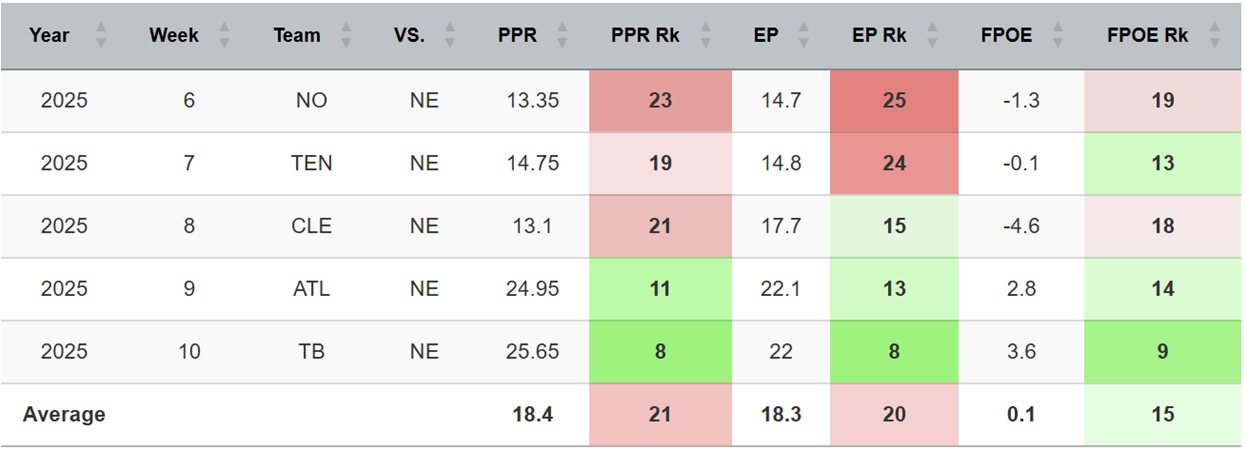
The Jets have had three players with better than 15% target shares in the last five games: WR Garrett Wilson (27.0%), TE Mason Taylor (19.1%), and WR Josh Reynolds (16.5%).
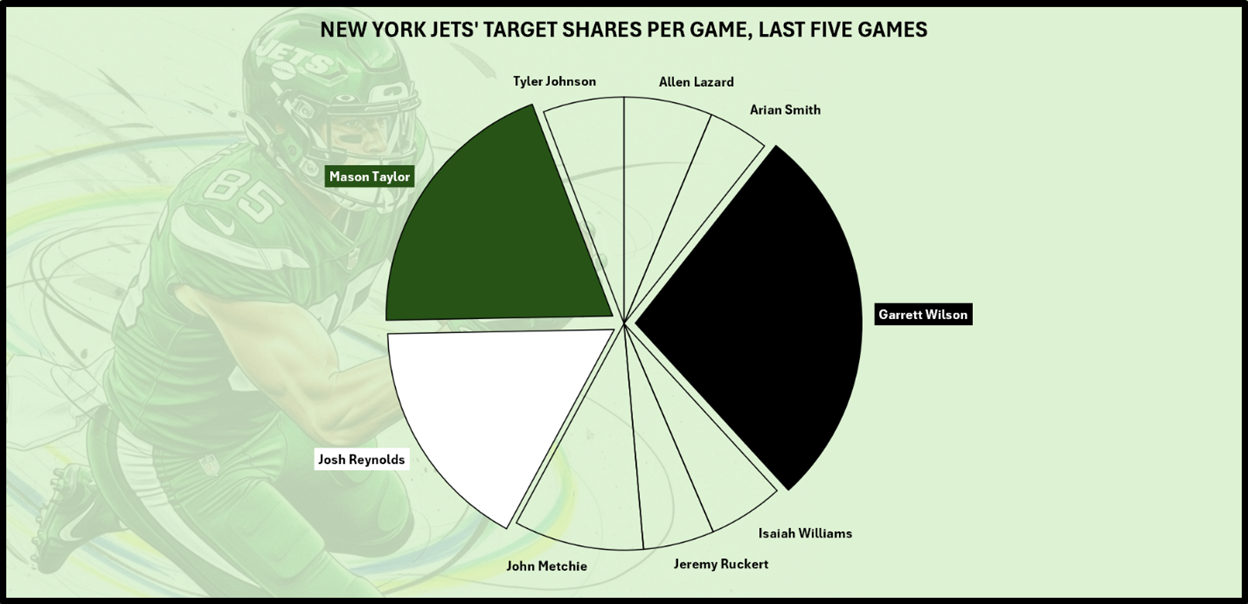
The Jets lost Wilson to a knee injury this week; he has been ruled out for TNF. They started the season thin at the position, and their de facto no. 2, Reynolds, has already been on I.R. since Week 8.
Based on how they deployed their WRs this last week, WRs Arian Smith and Tyler Johnson would seem to have the early edge on increased snap shares. However, John Metchie and Adonai Mitchell—both second-round picks in recent drafts, both recently acquired in trades—are wildcards here. It wouldn’t be surprising to see either or both of them taking on larger roles, although these processes can sometimes take time, and this doesn’t mean it will all happen at once on a short week.
I would look for Johnson to be the best start this week among the WRs (although ostensibly unstartable in most circumstances), but I’d also bet Metchie and/or Mitchell emerge somewhat as the season goes along.

Of course, passing volume doesn’t have to go to clones stepping into the same shoes. An obvious choice for a higher market share is Taylor; another is RB Breece Hall, who has more than proven he has receiving chops.
Taylor’s already been a highly volatile option, bouncing from TE1 production to complete impotence like he’s on a pogo stick. But this isn’t the argument this week. This is a classic “who else is there” case, and it’s pretty compelling. But I don’t think it’s enough to guarantee a sale. In managed leagues, there still may be better options, although I concede that Taylor could work.

The Jets are overmatched in pass blocking, allowing the highest Pressure Rate Over Expected (PrROE) on offense (21.36%). The Patriots generate pressure at a rate of 6.98%. When the two are combined, the Jets are expected to have the most significant disadvantage in pass protection this week.
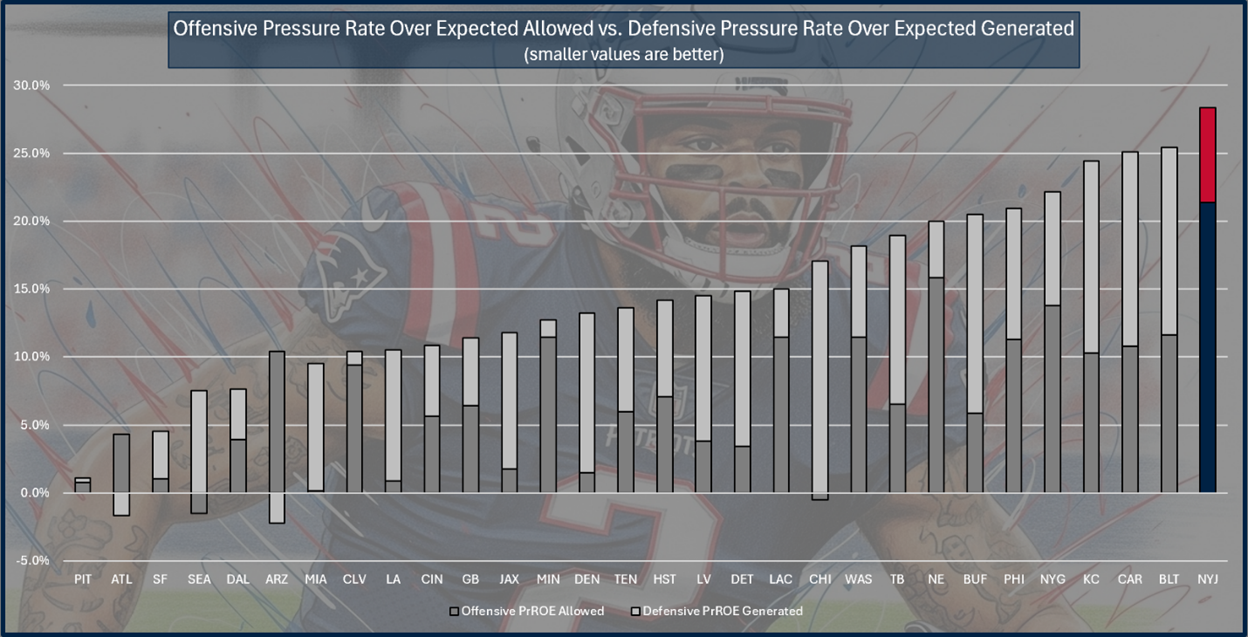
New England’s defense ranks ninth in EPA per play allowed and 15th in defensive success rate. They rank 13th in EPA per dropback allowed and 21st in defensive success rate on dropbacks.
There is not a great deal of difference between Fields under pressure vs. Fields from a clean pocket. Sometimes, this can be a compliment—we might say so-and-so handles pressure well, as might be the case with Joe Burrow, for instance. However, in this instance, the lack of disparity is primarily because Fields is not particularly effective from a clean pocket to begin with.
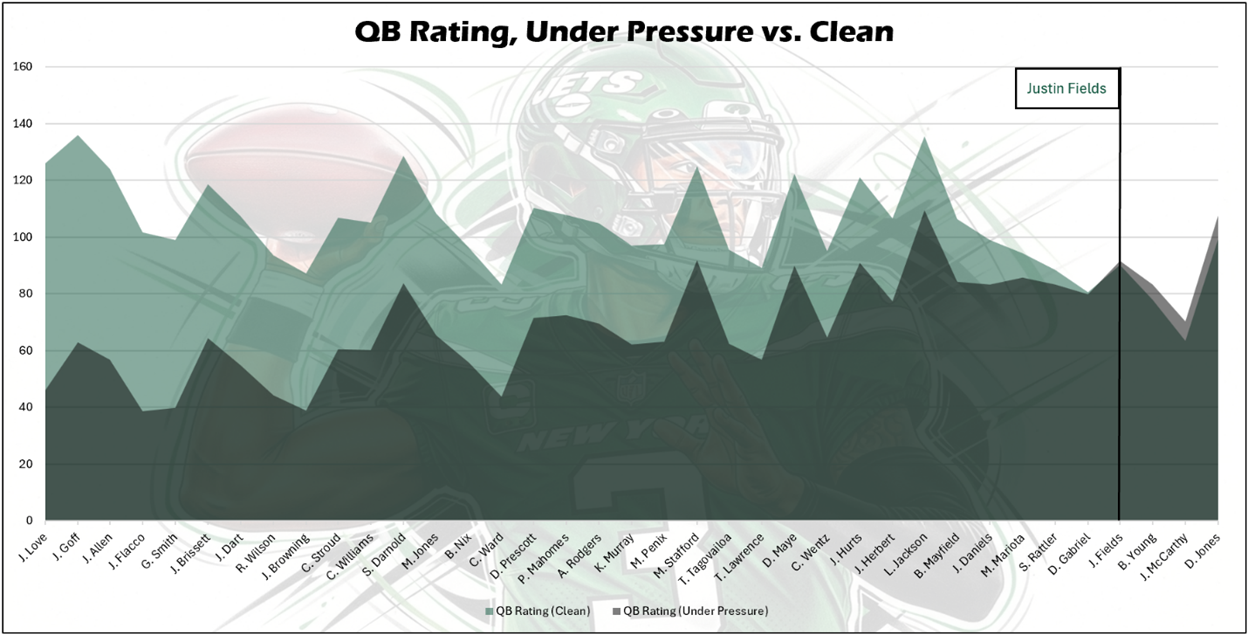
Like most teams, the Patriots primarily employ a zone defense, although they use man-to-man at a rate of 26% (13th). They bounce back and forth between two-high and single-high safety looks at a rate of almost exactly 50/50. They use three separate alignments at a rate of at least 20%: Cover 3 (27.6%), Cover 1 (22.8%), Cover 2 (20.3%), and Cover 4 (20.1%). They blitz at a rate of 22%, which is average.
Fantasy Points’ coverage matchup tool assigns a zero-based matchup grade to each pass-catcher based on their opponent’s use of specific types and rates of coverage and how that pass-catcher performs against them. Positive numbers indicate a favorable matchup and negative numbers indicate an unfavorable one.
Based on this, Taylor has a slightly unfavorable matchup at -5.1%. Johnson's (-11.3%) and Smith’s (-13.3%) are worse. There is not enough data on Metchie or Mitchell to qualify.
PFF’s matchup tool is player-based, pitting the PFF ratings of individual players against each other for an expected number of plays based on historical tendencies and rating on a scale from great to poor.
Unfortunately for New York, it only gets worse there: the Patriots’ defensive backfield is a lot to handle for a quality receiving corps; this collection of misfit toys doesn’t pair well against the likes of CBs Christian Gonzalez, Marcus Jones, and Carlton Davis, or a safety like Jaylin Hawkins. According to PFF’s tool, Taylor’s matchup grades out as fair, Hall’s receiving matchup grades out as good, and everyone else’s grades out as poor. You cannot choose to play anyone in this offense in most managed leagues other than Fields, Hall, or Taylor.
Turning to more traditional stats, the Pats have been a neutral matchup against WRs in terms of fantasy points allowed. This is not the strongest set of foils either.

Things are about the same for TEs. Again, not the toughest competition. The only inkling of a difference here is that WRs have gotten by in the last five games against New England with efficiency; for TEs, it’s been more about opportunity. But don’t read too much into that. Small sample, narrow disparity—nothing to paint on the wall.

For me, Hall is the clear choice if I’m the Jets, and I’m looking for someone to funnel my passing work through.
Early on, Hall was forced into an annoying timeshare with RB Braelon Allen, who has been out since Week 4 with an MCL injury. The split has been more bearable for GMs who invested in Hall since.

Since Allen went down, Hall has been an RB1 three times in five games (and one of the two where he failed to pay off was against Denver, one of the best defenses in the league).
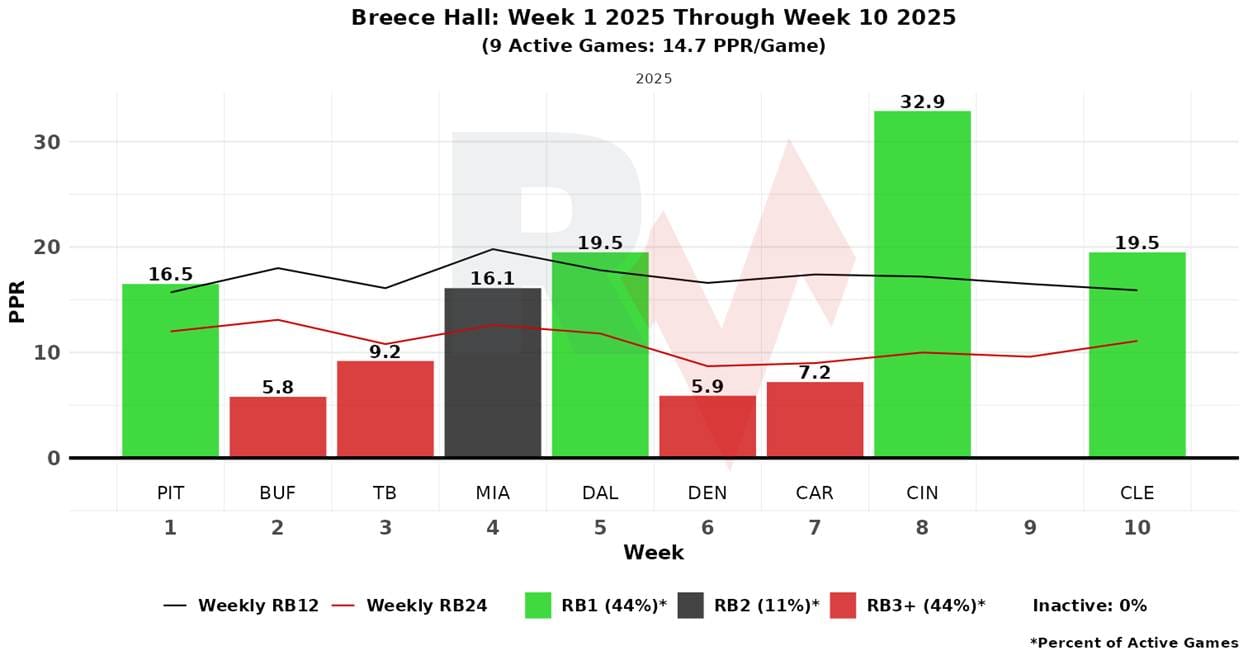
The Jets rank 22nd in offensive EPA on rushes and 14th in offensive success rate on rushes—the strength of their offense. Of course, the Patriots rank 4th in EPA on rushes allowed—the strength of their defense—and eighth in defensive success rate on rushes.
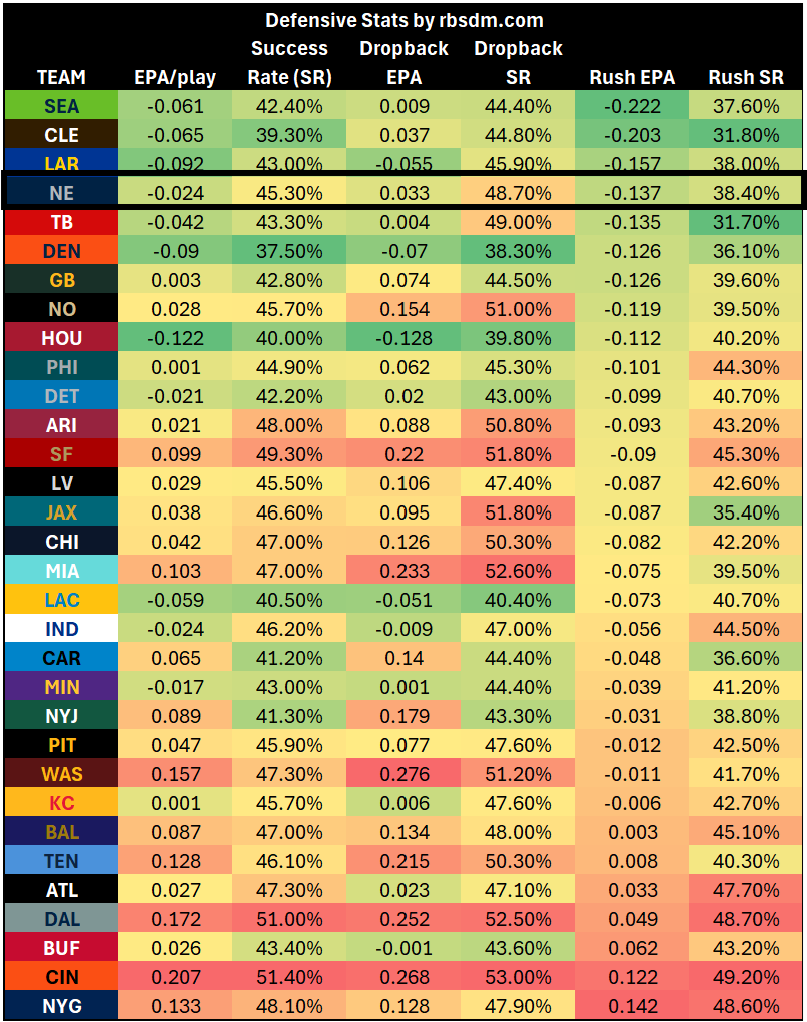
At this point, the time for games may be over if the Jets want to be competitive in this game. Hall is an effective runner, although perhaps not as efficient as he was in his first two seasons, before a significant injury. He still ranks top ten among RBs in rush yards over expected per attempt (RYOE/Att) with 0.88 RYOE/Att (8th).
Hall is still incredibly explosive. 10.9% of his rushing attempts have gone for 15 or more yards this year, the most of any RB in the league—ahead of Jonathan Taylor (7.9%) and De’Von Achane (9.1%).

The Jets also hold a slight advantage in run blocking. They generate 2.69 adjusted yards before contact per attempt (Adj YBC/Att), tied for second in the NFL. The Pats are strong in this area defensively, as well, allowing just 1.43 Adj. YBC/Att. This still leaves the Jets with a significant run-blocking advantage.
What is so strange about Hall is how effective he was as a receiver early in his career, and yet, every coach for the past two seasons seems hesitant to keep him tied to a role where he is used expansively in this capacity. Davis has a higher market share (11%) than Hall (9%). But Hall, who has two 50-catch seasons under his belt already, could be unleashed in the passing game. It would potentially provide a lifeline if the Jets meet resistance from this tough New England run defense, or if they fall behind, as we’d expect.
What’s more, the Patriots have a demonstrated weakness against pass-catching RBs, as they have allowed more receiving yards to fantasy RBs than any other team.

It certainly seems like one way the Jets could try to wage their attack with so few weapons. That’s entirely up to the coaching staff, however, and out of our control.


